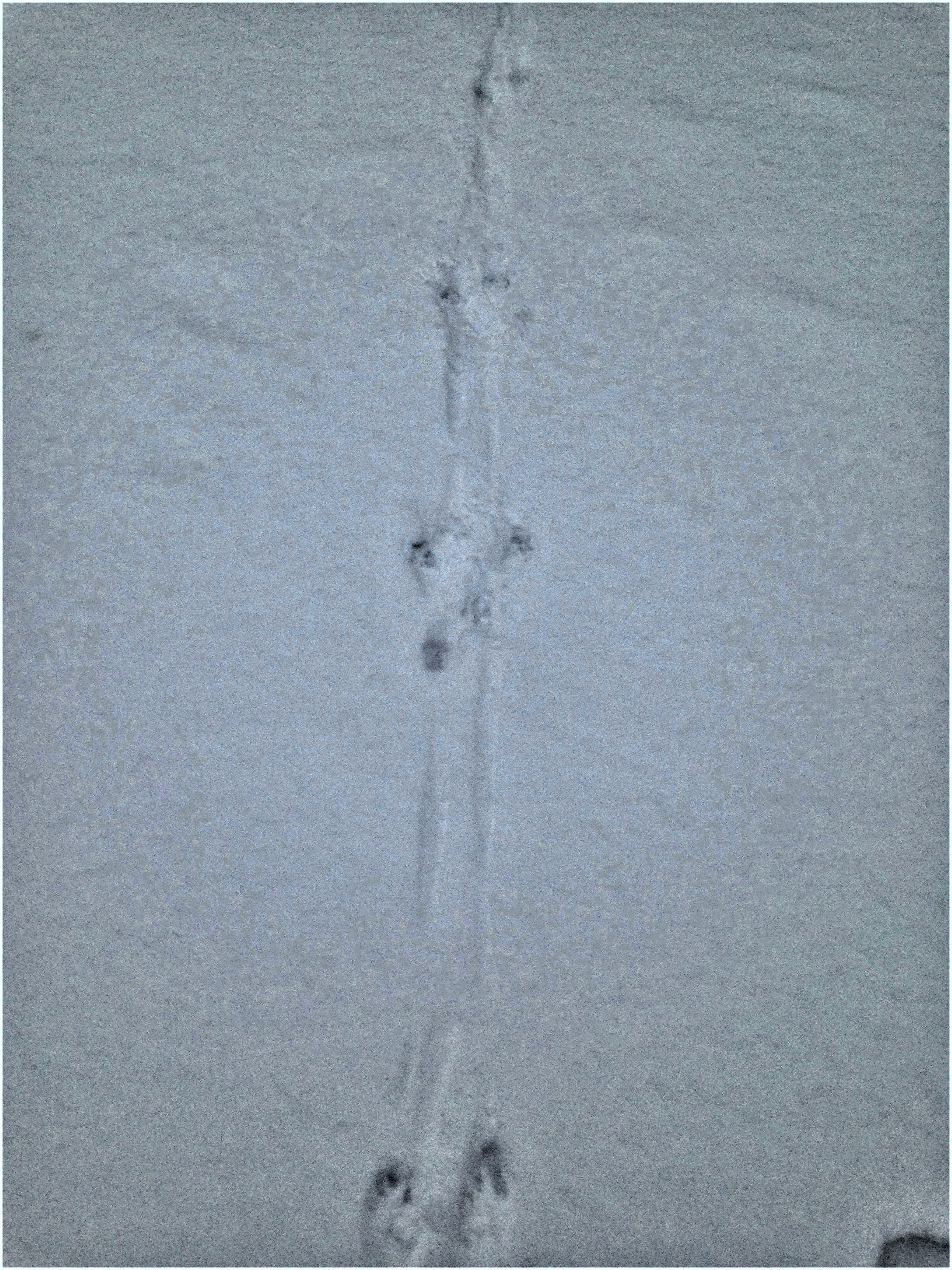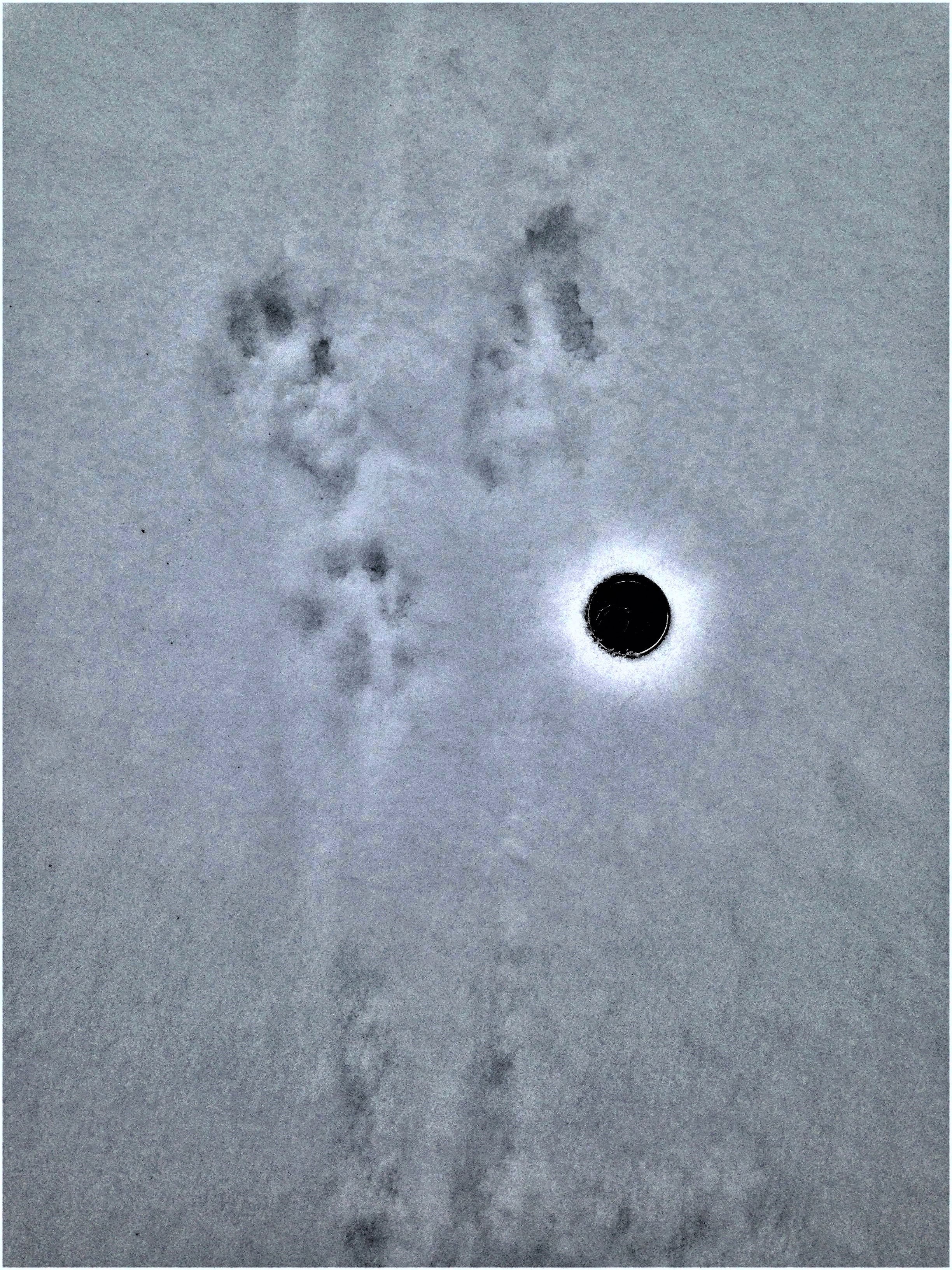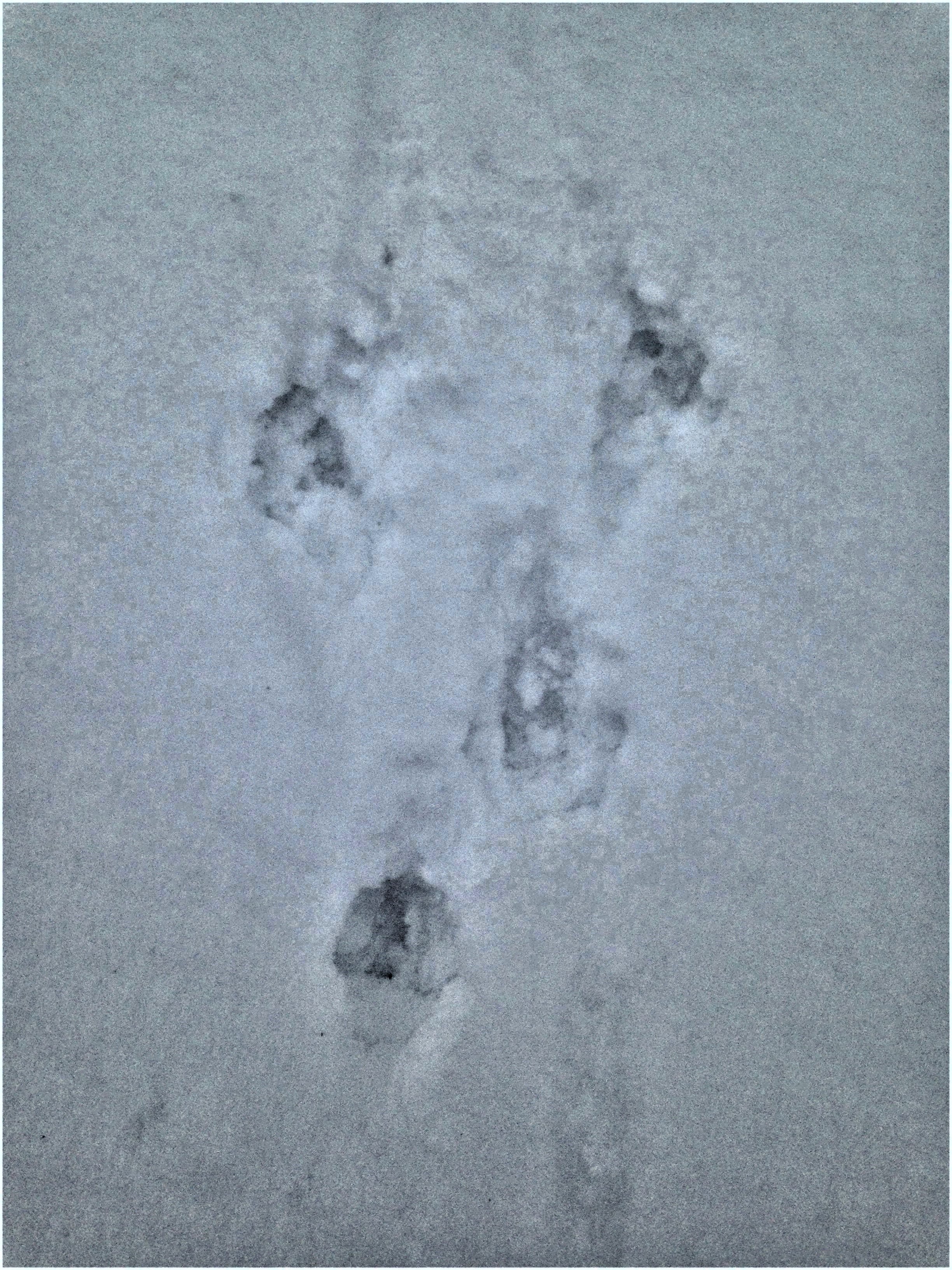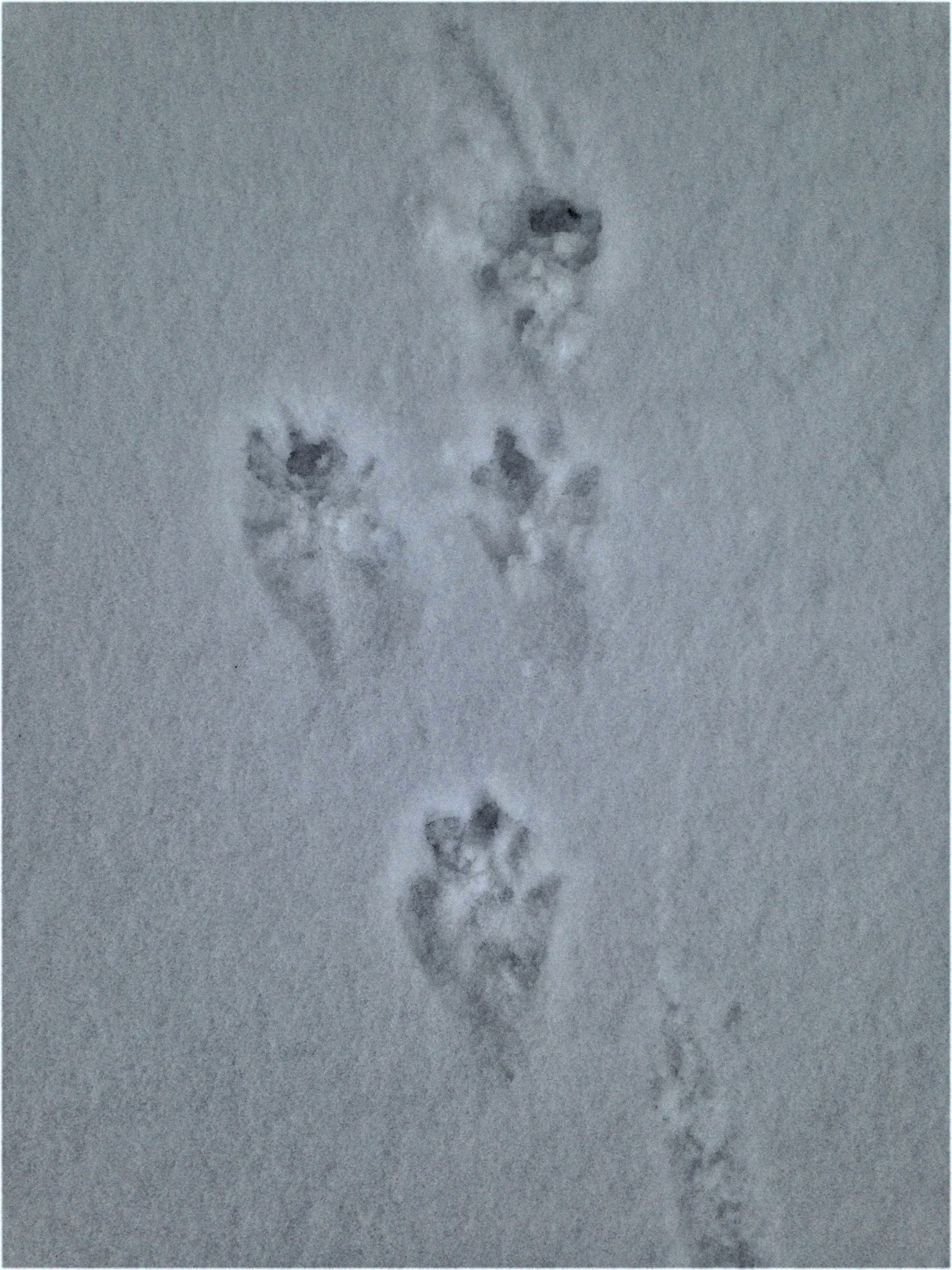Eramosa River tracking journal, 2022.01.23
I left the house just before 8am so I could get out before too many people were out walking their Dogs (Canis lupus familiaris). There ends up being a bit of a jumble in the trails when the Dogs come out and it’s just easier to spot everything without much distraction. I also feel a little weird sometimes, standing in the middle of a path, road or even the frozen river where everyone is walking by. If more folks stopped to ask about the tracks or even say hello it would feel less awkward, but usually they just stare, and then walk by cautiously while their Dog barks at me. Even the Dogs know there is something amiss about a person standing there noticing the world. I recount a bit of these feelings because it happened again this morning while I was checking a Grey Squirrel (Sciurus carolinensis) bounding trail along the road by my house. The interaction wasn’t long but it must be strange for a neighbour I don’t know yet to see a man standing in the road staring down at what appears to be nothing. But for me it was so much. I was looking for the reduced toe 1, located on the inside of the front tracks, in the tracks in the snow. I could see slight depressions on the edge of the metacarpal pad, but not much more. Toe 1 rarely registers for Grey’s so it makes for a fun thing to try and find in a rather ubiquitous track.
I kept on through the wakeing neighbourhood passing a couple more Dog-walkers and heading out towards the frozen river I had been walking on for the past couple of weeks. I wasn’t in search of anything in particular, but instead just paying attention to the spots I habitually visit in hopes to see new signs of life, or death, on the trail. I walked by a spot where a couple of weeks ago I came across a Deer Mouse (Peromyscus maniculatus) with their head bit open and the brain missing. I had initially thought a bird of prey, but I later saw an image in a book which looked just like my discovery, a mouse with the brain missing, with a capti0n about a Short-tailed Weasel (Mustela erminea) having been the predator. I passed the spot where last summer my partner and I were out canoeing and we saw a group of five Raccoons swim from the SouthEast bank across the river to the NorthWest bank, then one going back to the side to the SE side, then three Raccoons joining the four remaining on the NW, making for 7 Raccoons in total. It was a long wait in the canoe, but it was worth it.
When I came to a wooden wall framed with rusty steel H-beams I walked around behind it, so I was on the side of the river when I looked down and found what I had come over in search of: Weasel tracks.

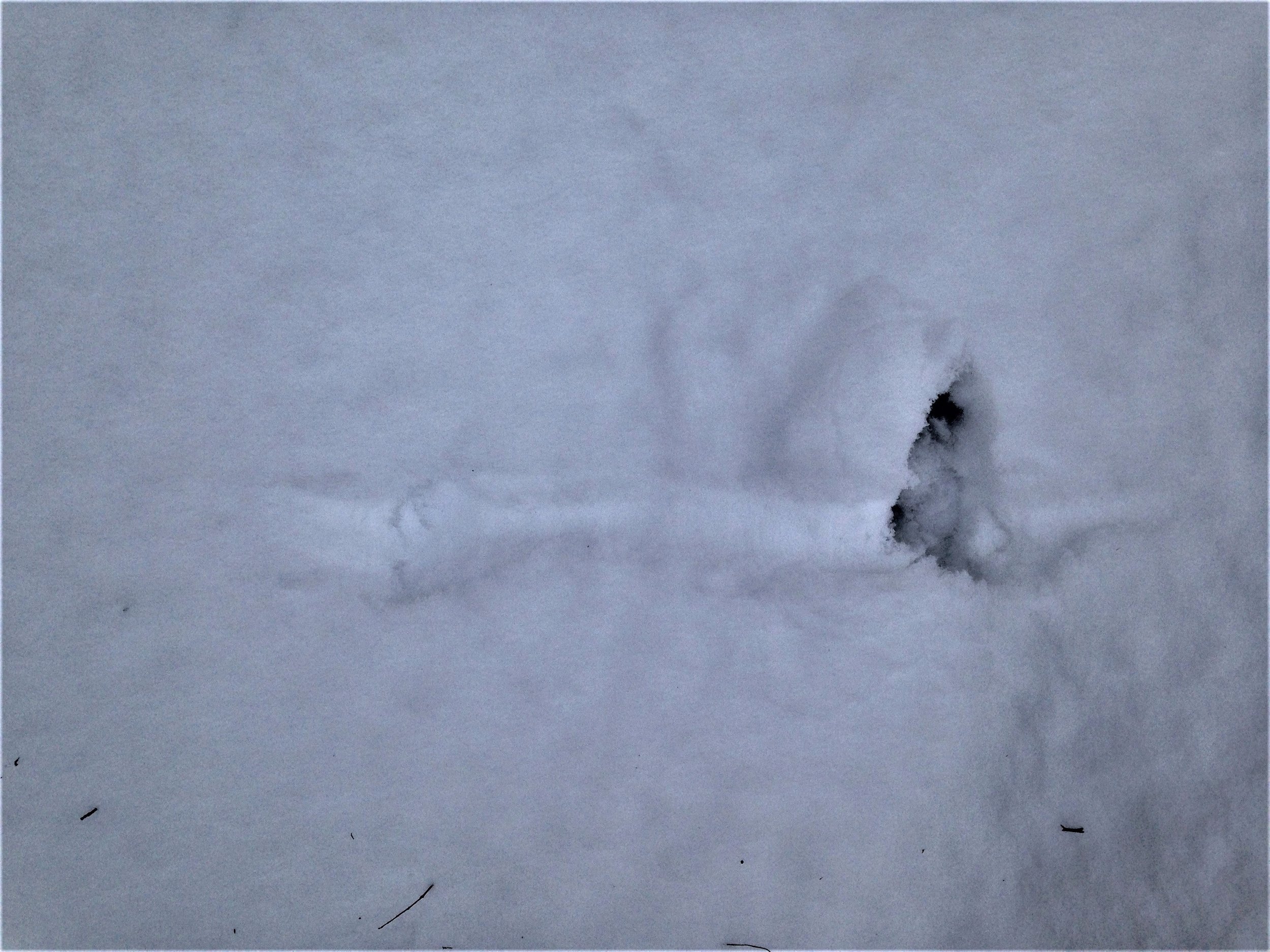


I took some photos (which have been edited for clarity) and some measurements. Before the tape measure came out I noted that the trail looked a bit on the larger side of a Weasel, but looks can be deceiving so it is always good guess my top 3, then take a couple measurements to narrow it down. The trail width, which is a good tool in differentiating between the smaller members of the Mustelidae family, was an average of 4 cm ( 1 9⁄16 in) for the 2x2 loping gait that the animal was moving in, though at a couple spots the trail width was 5 cm (2 in). This was in the range of both Short-tailed Weasel whose trail width for a 2x2 lope is 2.2 - 4.8 cm (⅞ - 1 ⅞ in)*, and Long-tailed Weasel (Neogale frenata) whose trail width for a 2x2 lope comes in at 3.5 - 7.3 cm (1⅝ - 2⅞ in). Since these numbers were so similar it was worth taking another measurement. I chose to measure the width of the individual feet though this would be difficult since the animal was moving in a 2x2 lope where the hinds land atop of the tracks previously made by the fronts. This can distort or obliterate the front tracks. But I tried to find a pretty clear looking track (the 3rd image in the gallery above) and measured the width of each foot, which came in at 1.6 cm (⅝ in) wide. This falls within range of a Short-tailed, 1.1 - 1.6 cm (7⁄16 - ⅝ in) wide, but not a Long-tail who comes in at 1.9 - 3 cm (¾ - 1 3⁄16 in) wide. The measurements were helpful. So far by a margin of 3 mm the tracks point to Short-tail but really they were close. This trail was a good reminder that when the measurements are close or overlap like this it points to the sexual dimorphism found in many of the species within the Mustelidae family, with the males being larger than the females across the genera, so much so that males of some species can grow to more than double the size of the females. So if the two species are overlapping it would mean that the trail I was looking at was left by either a male Short-tailed or a female Long-tailed. When considering these two different species it helps to also look beyond the measurements and broaden the scope to the behaviour and environment. Short-tails most often leave trail patterns of short strides alternating with long strides in snow. Long-tails leave a varied pattern of short and long strides zigzagging all over the place. The stride length for the trail in the images above was 48 cm (18 ⅞ in), 22.5 cm (8 ⅞ in), 40 cm (15 ¾ in), 24 cm (9 7/16 in), which matches the long stride/short stride/long stride/short stride/etc… trail of the Short-tail. The short strides alternating with long strides pattern was also seen in other trails nearby when I returned later in the day (close to sundown) to get more measurements and photos of different trails near to the one pictured above.
Body print with tail print, edited for clarity.
Another sign of possible Short-tail was a depression at the rear of one of the body prints. I didn’t think until after I had returned from my second visit (and after the sun went down) to measure the length, but considering that the coin beside it measures 23.88 mm (15/16 in) in diameter, and that quarter would fit roughly 3 times within the length of the tail it could come out to ~ 69 mm (2 ¾ in). While this could be a partial print of the tail, it would fit the length of a Short-tail whose tail comes in at 69 - 98 mm** (2 ¾ - 3 ⅞ in). The Long-tail’s tail however measures 141 - 186 mm (5 9/16 - 7 5/16 in).
It seemed like overall, with the varied measurements of the trail width, foot width, and stride length, and tail length, along with the behaviour of the animal as demonstrated by short strides alternating with long strides, a picture of the Short-tailed Weasel develops. One thing that was interesting that I found out in my research is that both Shorts and Longs are capable swimmers. Before researching for this post I thought that only the Long-tail was a swimmer. This complicates the analysis in the future, but makes for a broader and more nuanced understanding of the two species and their relationship to place… and that’s really what I am after when I am out tracking. I want to know the nuance and the details. I want to see complexities and individuation of species and also see the overlap and commonalities. Nature, and I definitely include myself in concept, is broad and fine and tracking just demonstrates this over and over again, and that’s the thing that brings me back.
I tucked up around the wall the Short-tailed Weasel had been wandering near and got up on a train bridge to cross the river, where I then descended the other bank onto the frozen river and made my way towards where I had found a dead Herring Gull only a couple of days before. As I approached I noticed that there appeared to be Canine (Canis sp.) tracks leading towards the spot where the Gull had been, but was apparently no longer. All that remained was a depression in the snow about the size and shape of the bird that been there previously. Just East of the depression in the snow, downwind of it, there was a small feather half concealed in new snow. I walked up to and noted that there was a Canine trail leading around a grassy peninsula and in towards the woods, so I followed the trail. It was tricky going because I know the ice gets weaker where the water meets the land, and around this peninsula the plants growing at the edge would make the ice even more fragile. I carefully made my way onto the grass area and noted some blood and urine in the trail in front of me. When it registered I got excited. I had been searching in Coyote (Canis latrans) tracks and Red Fox (Vulpes vulpes) trails for any signs of estrous but I had not seen any so far. However strange it may be, it feels like a seasonal rite to see the dribbles of blood and if I don’t find them, I feel like something was missed. There have been so many Fox sightings recently amidst my colleagues at work and among my friends that I wanted to share in some of the Fox lore happening about the area. I bent low and sniffed at the urine marks placed around the long impression in the snow. The impression was long, trampled and I thought it looked a little like a bed, but not quite right for the bed a Fox or a Coyote. Finding dribbles of urine and perhaps even a little bit of estrous blood would make sense in a bed as well so that part fit. I have found Fox beds a couple of times and they are fairly circular. This one was not circular at all. Perhaps it wasn’t a bed after all? I dug at little bit of the blood with my foot and dislodged it. That’s when I saw that the blood was connected to some fur, Eastern Cottontail Rabbit (Sylvilagus floridanus) fur, and beside the fur was part of the distal colon of a Cottontail, including 2 scat pellets.
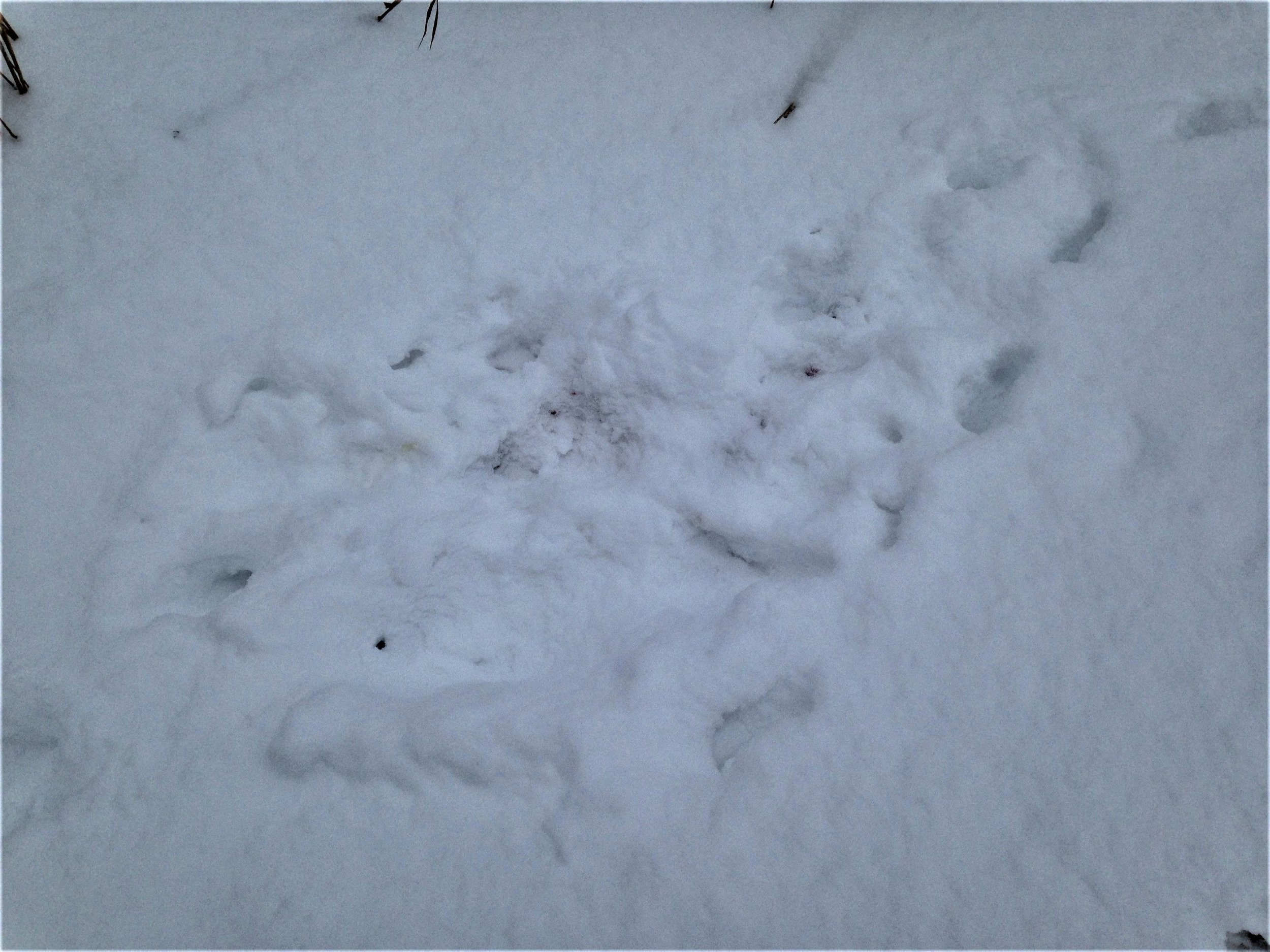

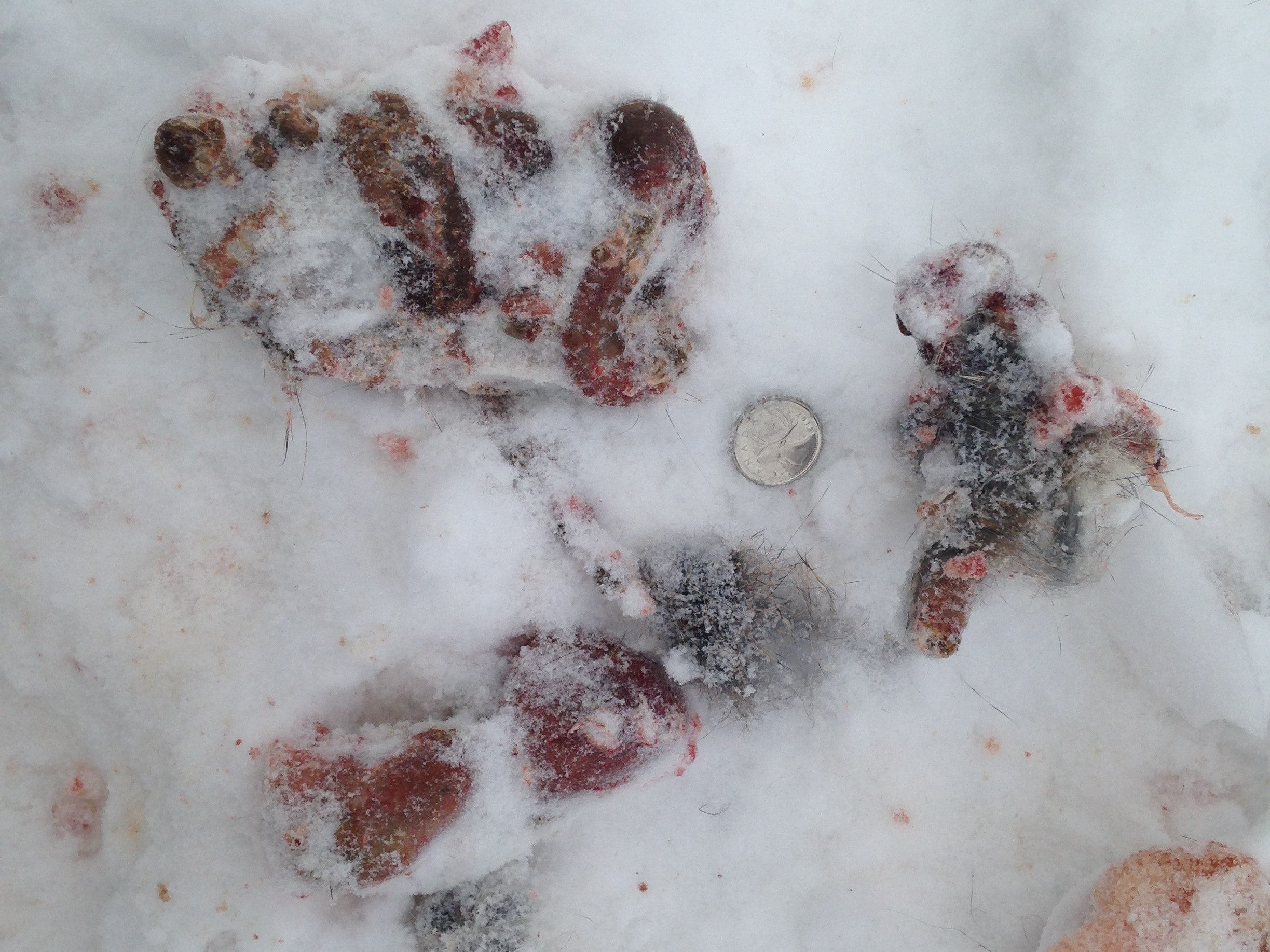
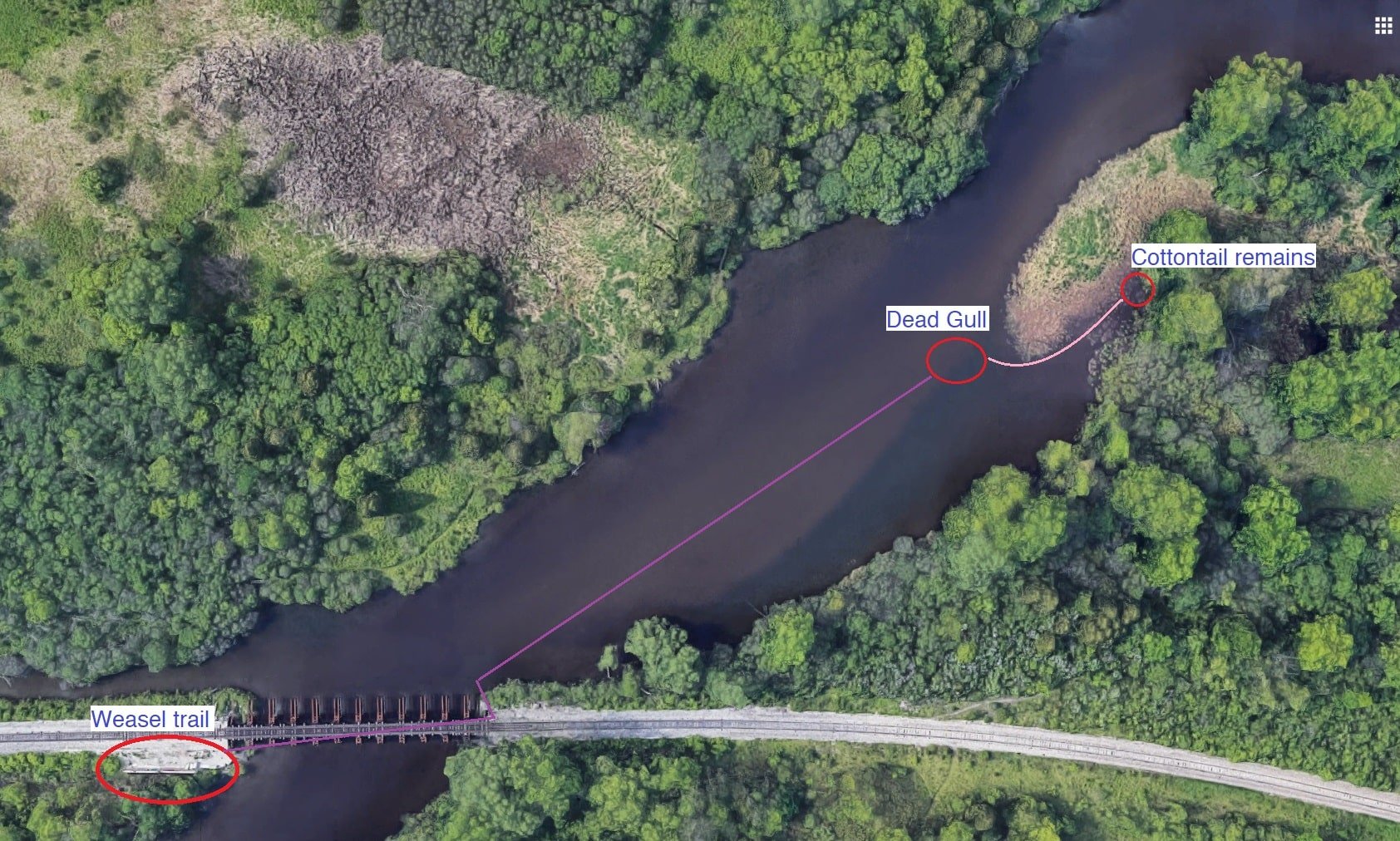
When I begin to find the remains of a Rabbit, I tend to keep looking around, to dig a little deeper, and see what else might be found. A lot of the time, when I find Cottontail remains there are certain pieces of the remains that show up more often. Most commonly it is the viscera, or the intestines and other internal organs related to digestion. As I dug I found what I was expecting. Looking at the photo above with the internal organs showing there was the stomach (lower middle left of the photo), part of the proximal colon and caecum (upper left of the photo), more of the proximal colon, the fusus coli and part of the distal colon (middle on the right side of the photo). These seem to be parts commonly left behind along with the occasional foot, tail and sometimes the upper front part of the skull (rostrum, and upper palate). Any time I come across these Rabbit remains I try to take the time to look at the remainders so I can better understand how Rabbit digestion works. I hope to write a zine about Eastern Cottontail anatomy through kill site analysis in the coming months, and I have begun working on it, but honestly, I just havn’t come across many Cottontail kill sites this winter. This was one of, or maybe even, the first. It was exciting for sure.
I had smelled the urine and it was totally skunky, making me lean towards this kill being made by a Red Fox, but I couldn’t tell for sure. After I buried the remains once more (so whomever could come back and eat whatever they wanted of the leavin’s), I took note of the trail leading Northwise across the grassy point bar back towards the frozen river. The canine quickly sped up and made their way in a gallop. A gallop gait usually implies that the animal was either chasing something down, or running away from something that may have spooked them. I didn’t see any intrusive tracks like humans (Homo sapiens) or Dogs but I don’t think they were hunting just coming from a kill site with possible edible bits still left cached in the snow. I followed along for a little but then got off track by navigating the river.
There really wasn’t much going on on the river for the next while but I watched for birds and kept walking towards an old train bridge which I decided was my marker to get off of the river. Last year I had been following a Mink (Neogale vison) trail along the edge of the river when just past the bride, the ice cracked quickly and I had fallen in. I had decided I didn’t want to try it again this time. But luckily I came along a Mink trail before the bridge, but this one was kind of strange.
The trail featured some gait changes where the foot falls were landing in forms that didn’t make the most sense to me at first, or just different from what I normally see from a Mink along the river. It looked like the Mink was moving in a variety of gaits, some seemingly similar to an Eastern Cottontail. According to Mark Elbroch’s Mammal Tracks and Sign, the Mink will bound when moving across open exposed spaces. Sadly it has been over a week since I was out tracking this Mink I can no longer remember which way they were going along the river.
All the images in this gallery are edited for heightened clarity. I made these edits in Microsoft Photos, using the Clarity slider under the Adjustments tab. This option really draws out some invisible details in the tracks which I find helpful when studying the photos. One detail from the second image shows all 5 toes on the left front foot which lands leftwards of the coin (which got blacked out and has developed a corona around it through the editing process). A couple of the toes were nearly invisible in the original. As you look at the image you may wonder where the right front foot landed? I wonder that as well. My assumption is that is would have landed a little up and to the right of the left front which is now clear and visible. This would mean though that as the fronts lifted off and the hinds came down, the right hind must have landed atop the the impression of the right front, erasing it. This is just an assumption based on how members of the Mustelid family move.
In the next image, all four feet are clear, with the left front, right front, right hind all running up from the leftish midline of the photo forming a diagonal line. The left hind is opposite and a tiny bit lower than the right hind. When Rabbits do this, my friend Tamara Anderson describes this as lower case “y” shape.
In the final image of the set, again all four feet are shown but I can’t seem to make out which foot is which for certain. I believe it to be the right front at the base of the group, but then I am uncertain as to which feet are which beyond that. I can imagine that since the group pictured indicates a lope that the other front is in that middle row of feet, but I am unsure which is which.
The confusion over the Mink trail reminds me that I should take my time with some trails, especially the more difficult ones, which I tend to move quickly by when I find them. Instead of evading the work of trying to see what is going on better in hopes of finding something more identifiable I should be hunkering down and looking at the trails and patterns more carefully, taking the time to wonder and be in the mystery of it. I have been successful lately in wondering after canine trails, so I should take my time with the Mink as well.
I ended up walking along the frozen river until I got to a bridge. I went over the river via the bridge and headed back in the direction I had come from, and then happened to run into a friend and their Dog, both of whom joined me for the walk home. It was a fun outing. I did end up heading back out just before sunset to get a couple more photos of the Short-tailed Weasel mentioned above, but I already explained all of that. Perhaps I’ll get out tomorrow as well.
Happy tracking!
*All range measurements come from Mark Elbroch’s Mammal Tracks and Sign (Stackpole 2003) .
** Tail measurement comes from Donna Naughton’s The Natural History of North American Mammals (Canadian Museum of Nature and University of Toronto Press, 2012.)
To learn more :
Harcourt-Brown, Frances, Textbook of rabbit medicine, Oxford, England: Butterworth–Heinemann, 2002.


